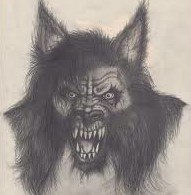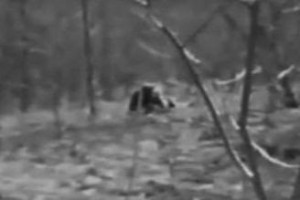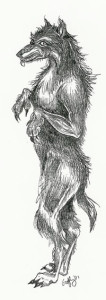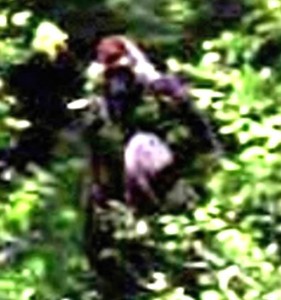“People don’t like wolves that can think like people, an’ people don’t like people who can act like wolves.”—Gaspode
After the Jersey Devil, probably my favorite lesser-known cryptid is the Michigan Dogman. Although he doesn’t restrict his appearances to just one state (or even one country) as his name implies, he is most often seen in northern Michigan. He’s actually more of a wolfman, just like the Mothman is more of a batman, but both of those monikers were already taken by the time these critters were named by modern Americans. There have also been multiple sightings of two or more of  them together, so they might be more correctly referred to as Dogmen. And now that I think about it, I’ve never heard a single description of it/them where any sort of external genitalia was mentioned. Since one of the most unusual things about their behavior is that they are frequently seen walking upright on two legs, one would think that this anatomical detail would be easy enough to spot. In light of this, maybe they should be called Dogwomen.
them together, so they might be more correctly referred to as Dogmen. And now that I think about it, I’ve never heard a single description of it/them where any sort of external genitalia was mentioned. Since one of the most unusual things about their behavior is that they are frequently seen walking upright on two legs, one would think that this anatomical detail would be easy enough to spot. In light of this, maybe they should be called Dogwomen.
The first recorded sighting of a Dogman (or woman) by a European was in 1804 when a French trapper reported an encounter with a loup garou (werewolf). As is usually the case, Native Americans in the area have been aware of these creatures for much longer than this, and their beliefs about them go beyond the idea that they are just an unusual variety of larger than average wolves that sometimes walk on two legs. I’ll get more into that later when I address some of the seemingly paranormal aspects of these creatures that will make the “cryptids are just unidentified animals” crowd cringe.
The first known Dogman sighting in what I suppose we could call the modern era was in 1936 and was not in Michigan but Wisconsin. A man was driving down a highway just outside of the town of Jefferson when he saw what he thought was a man digging in a field that was supposedly once a Native American burial ground. When the guy slowed down to take a closer look, the “man” in the field stood up and turned to face him. The driver then saw that the creature was what he later described as being part dog and part ape. It was covered with dark fur and had the body of a large, powerful primate, but with a dog’s head. And if that’s not hard enough to believe, this guy went back to the same field at the same time the next night to see if he could get another look at this thing, and he did. It was right there in the same spot, but apparently now it had lost its patience with being interrupted, because this time it growled what the man thought sounded like the word “Gadara” at him. That seriously frightened him and he sped away.
It has been pointed out by some individuals of a certain frame of mind that Gadara was the name of the town where Jesus cast out the “legion” of demons from a man and into a herd of swine. They take this as indicating that the Dogman is some sort of demonic beast, but I think that’s a bit of a reach. One even goes so far as to say that these things are actual werewolves who gained their shapeshifting abilities through a pact with Satan. There are a number of obvious problems with this theory, namely that it’s ridiculous. Also, there is some theological debate about exactly where this casting out of devils occurred, with Gadara only being one possibility. And Dogman’s eyes don’t even glow red like demonic entity’s eyes are supposed to, except for a few times when he was seen with headlights shining in his face, and lots of animals’ eyes do that. But enough about religio-paranoid stupidity.
 The first modern encounter with the beast in Michigan was in 1961. A night watchman at a factory located in a rural area adjacent to the Haymarsh State Game Area outside of Big Rapids, Michigan saw a large shape moving around outside of the chain link fence surrounding the building. Since it was three o’clock in the morning, he was naturally suspicious and kept a close eye on the “person” to see what he was up to. As he watched, it became obvious that this was no man. It appeared to be covered with dark fur, was taller and broader than a human, and it moved on four legs, pausing now and then to stand upright. The guard managed to snap a picture of the thing as it moved under a light, which I’ve posted here. It doesn’t look like much to me, but it also doesn’t look like any sort of animal native to that region. He also said that the creature gave the impression that it was looking for something. It ran off into the woods just after its picture was taken. Cryptids are notoriously camera shy.
The first modern encounter with the beast in Michigan was in 1961. A night watchman at a factory located in a rural area adjacent to the Haymarsh State Game Area outside of Big Rapids, Michigan saw a large shape moving around outside of the chain link fence surrounding the building. Since it was three o’clock in the morning, he was naturally suspicious and kept a close eye on the “person” to see what he was up to. As he watched, it became obvious that this was no man. It appeared to be covered with dark fur, was taller and broader than a human, and it moved on four legs, pausing now and then to stand upright. The guard managed to snap a picture of the thing as it moved under a light, which I’ve posted here. It doesn’t look like much to me, but it also doesn’t look like any sort of animal native to that region. He also said that the creature gave the impression that it was looking for something. It ran off into the woods just after its picture was taken. Cryptids are notoriously camera shy.
In the mid-1970s, three men paddling a canoe down a shallow river that ran behind a cemetery near Alpena, Michigan saw a large dog running down the shoreline behind them. They didn’t think much of it until they heard a splash. Looking back, they saw that the “dog” was now swimming after them, then rose out of the water and continued to follow them by wading through the water on its hind legs. Completely freaked out, they began paddling like crazy to get away from this thing, which they seem to have done rather easily. Apparently, the creature lost interest in chasing them down fairly quickly.
Most sources of information about Dogman simply detail a number of encounters, the majority of which are pretty similar, but with a few notable exceptions. One of these is the story of two young men who happened upon a deer in a clearing. As they watched, a huge dog raced into the clearing, snatched the deer and carried it off into the woods. That’s not typical wolf behavior. Another involved a local Michigan elected official who saw a Dogman standing by the side of a remote road late one night. The man stopped his truck to have a better look, and the two of them just stared at each other for a time until the thing ran off into the forest. The man got out of his vehicle with a camera and took pictures of footprints left behind in the mud. He estimated that the prints were about seven to eight inches long, which is only slightly larger than ones that other witnesses have reported finding.
I suppose that I should briefly discuss what is known as the Gable film, which purportedly shows a boy with a video camera being charged by a Dogman. The story goes that the film was recovered from the camera found lying next to the dismembered body of the child. Its creators have since confessed to fabricating the hoax, and I mention it only in case some of you might still think that it’s real. To me, the creature in the film looks much more like a wolverine than any description I’ve seen of a Dogman, so even if it was legit, I’d write it off an isolated wolverine attack on an unfortunate  boy. As is almost always the case with unusual beasties, there are no claims that I’ve seen of a Dogman ever killing anyone. I’ve only found one account of a man being attacked by one, and he suffered only minor injuries. If a fanged, clawed beast weighing an estimated 300 pounds leaves you with only superficial cuts and scratches, I have to assume that either it wasn’t really trying to hurt you, or you’re making the whole thing up.
boy. As is almost always the case with unusual beasties, there are no claims that I’ve seen of a Dogman ever killing anyone. I’ve only found one account of a man being attacked by one, and he suffered only minor injuries. If a fanged, clawed beast weighing an estimated 300 pounds leaves you with only superficial cuts and scratches, I have to assume that either it wasn’t really trying to hurt you, or you’re making the whole thing up.
One of my favorite Dogmen stories is that of some teenagers who say that they saw a group of these creatures both walking on two legs and drinking from a stream. Rather than sticking their muzzles into the water to drink like normal canines would, these beings were kneeling at the edge of the stream and drinking by cupping their front paws together and scooping the water up to their mouths like humans. I think that’s adorable, but it freaked these kids out. If you’re wondering how they could even do this with paws, some of those who have gotten a close enough look have reported that their front paws have opposable thumbs, albeit clawed ones.
My absolute favorite Dogman story is the one where a ranger went to retrieve the body of a dead deer that some hikers had spotted near a trail. He loaded the carcass into the back of his pickup and was sitting in the cab looking at a map when he felt something jostle the vehicle. He looked in the rearview mirror and saw the top half of a large wolf that must have been on its hind legs. It was trying to use its front legs to awkwardly lift the deer out of the truck bed. The ranger was so unnerved by this sight that he started the truck and sped away in fear. I don’t remember whether the Dogman got the deer. I heard this story years ago and have been unable to track down the source.
Maybe the most famous and interesting alleged photograph of the Dogman is the one dubbed as the Beast of 7 Chutes, named after the region of Quebec in which the picture was taken. The photographer was taking a picture of a waterfall and was unaware that there was anything unusual about the photo until he noticed something strange in the bottom right corner. Advocates and Dogman true believers say that this is unquestionably a legitimate image of the beast. More skeptical analysts say that this is a classic case of pareidolia – the brain’s propensity for convincing us that we see things in what are actually random configurations of light and shadow. The jury is still out on this one for me, but I can’t blame the doubters. On the other hand, it is pretty cool, even if it’s an illusion. My question is: how did this guy even spot this in the first place? It’s not like it jumps right out at you. I could’ve had that picture hanging on my wall for years and never noticed anything out of the ordinary.
So what about those paranormal aspects of Dogman that I mentioned?
Like many assorted varieties of paranormal phenomena, the Dogmen have a propensity for showing up in the vicinity of water. They are also fond of cemeteries, abandoned buildings and crossroads. I couldn’t find and don’t recall any stories of them showing up on bridges, but it wouldn’t surprise me if they do that as well. Like most paranormal entities, there’s probably a huge discrepancy between the number of sightings made and those reported. There are at least two reported instances of them being hit by cars and suffering no significant injuries, which just isn’t normal. There’s at least one case where one was shot but stubbornly refused to show any ill effects from it, which is absolutely and inexplicably normal for cryptids. From Sasquatch to the wolf of Skinwalker Ranch to the Kelly goblins to the giant dogs of Marley Woods to the Dogman, these things just don’t seem to care if you shoot them. Most of the time, they don’t even flinch, even if they are seen to bleed. Most perplexing indeed.
Between 1989 and early 1991, there was a rash of Dogman sightings near Delavan, Wisconsin. The summer before all of this started, about a dozen dead animals were found in a ditch, and one animal control officer has gone on record as saying that at least some of them seem to have been ritually slaughtered. Shortly after this, occult graffiti was found covering the walls of an abandoned house in a graveyard, and melted wax was found on some headstones. This led some to believe that the appearance of the beast in their neighborhood was the result of activities by Satanists. Maybe, but it’s worth remembering that these creatures have been reported before and since these occurrences and sometimes hundreds of miles away. The only reason that I even mention this is that John Keel thought that somebody practicing black magic in the area had something to do with all of the weird goings-on around Point Pleasant, West Virginia in the late 1960s, including the appearance of Mothman. Unfortunately, he never publicly elaborated on exactly why he thought this, at least not that I’m aware of.
And saving the best for last, there is a second-hand story of two young men who were driving down a rural road one night when they drove past a Dogman standing by the side of the road – always a favorite hangout for cryptids. As they passed by, it even raised its arms and snarled at them. They said that it looked like something out of a werewolf movie.
As they were excitedly discussing what they had just seen, they both noticed that they passed a familiar “Welcome to Sparta” sign and quickly passed through the little town. As they continued their animated conversation, they were both shocked to once again see the “Welcome to Sparta” sign and  find themselves again passing through the town. Neither of them could understand how they had come to experience this alien abduction-like occurrence. Of course, there’s no proof that this was somehow connected to their Dogman sighting, but it’s hard to dismiss the possibility that these two trips through the Twilight Zone aren’t somehow connected. According to the story’s source, a friend of the two, both men are sticking to their original story more than 20 years later.
find themselves again passing through the town. Neither of them could understand how they had come to experience this alien abduction-like occurrence. Of course, there’s no proof that this was somehow connected to their Dogman sighting, but it’s hard to dismiss the possibility that these two trips through the Twilight Zone aren’t somehow connected. According to the story’s source, a friend of the two, both men are sticking to their original story more than 20 years later.
So that’s the scoop on Dogman, but before I wrap this up, I should mention that a Native American from this region told one investigator that we would never catch or kill a Dogman because they can step in and out of our world at will. He was obviously implying that Dogman is some sort of interdimensional being, and the same thing has been said about Sasquatch by multiple Native American sources in various parts of North America. Maybe that’s just a silly superstition, or maybe they know something that we don’t.






 The greatest of his Outer Gods, Azathoth, the blind idiot “god” who sits outside of time and space at the center of the primal chaos is the perfect personification of the cold, impersonal forces that govern Lovecraft’s mechanistic universe without thought or mercy. He perfectly symbolizes a cosmos that simply “grinds aimlessly on from nothing to something and from something back to nothing again, neither heeding nor knowing the wishes or existence of the minds that flicker for a second now and then in the darkness.” Although Lovecraft never directly stated this, it is implied that Azathoth created the various universes. Whether he meant to do so or was even aware that he had created anything is equally unclear. H.P.’s lack of a description of what exactly Azathoth is and what his motivations are is consistent with his “gods.” Doubtless he felt that maintaining a little mystery in regards to these beings only made them even more sinister and enigmatic.
The greatest of his Outer Gods, Azathoth, the blind idiot “god” who sits outside of time and space at the center of the primal chaos is the perfect personification of the cold, impersonal forces that govern Lovecraft’s mechanistic universe without thought or mercy. He perfectly symbolizes a cosmos that simply “grinds aimlessly on from nothing to something and from something back to nothing again, neither heeding nor knowing the wishes or existence of the minds that flicker for a second now and then in the darkness.” Although Lovecraft never directly stated this, it is implied that Azathoth created the various universes. Whether he meant to do so or was even aware that he had created anything is equally unclear. H.P.’s lack of a description of what exactly Azathoth is and what his motivations are is consistent with his “gods.” Doubtless he felt that maintaining a little mystery in regards to these beings only made them even more sinister and enigmatic. often, however, it was Lovecraft’s Cthulhu Mythos that was borrowed and expanded upon by other writers – a practice that continues to the present day and one which Lovecraft actively encouraged. As you could probably guess, most of it isn’t very good, and some of it misses the point of Lovecraft’s dark surrealism completely. Nevertheless, the dark dream continues…for better or worse. There are even Lovecraft/Cthulhu Mythos role-playing and video games if you’re into that sort of thing. Personally, I’ll just stick to the stories.
often, however, it was Lovecraft’s Cthulhu Mythos that was borrowed and expanded upon by other writers – a practice that continues to the present day and one which Lovecraft actively encouraged. As you could probably guess, most of it isn’t very good, and some of it misses the point of Lovecraft’s dark surrealism completely. Nevertheless, the dark dream continues…for better or worse. There are even Lovecraft/Cthulhu Mythos role-playing and video games if you’re into that sort of thing. Personally, I’ll just stick to the stories.